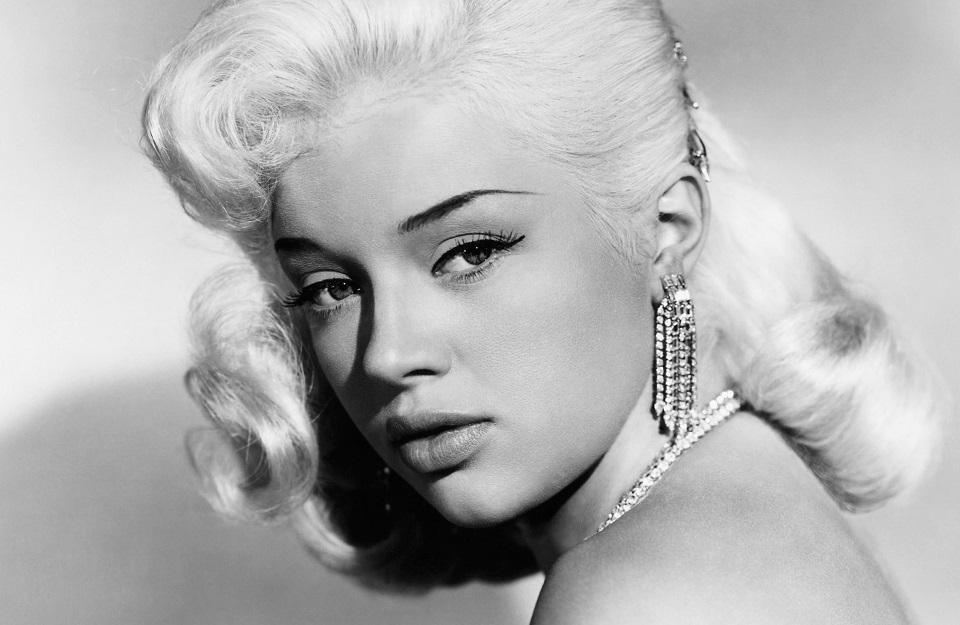
She was called “The British Marilyn Monroe,” but in fact, in very telling ways, their paths and personas were quite diverse. The difference conveys some important truths about Diana Dors’s society of Britain, one that was more class-based, and Marilyn’s America, hell-bent in the 1950s on erasing any traces of class consciousness.
Both came to prominence in the oversexed—because in actuality horribly repressed—middle and late 1950s where misogynist terms like “sexpot” and “bombshell” were applied to any actress (though not to actors) who gave off even a whiff of sexual liberty. With Marilyn Monroe (1926-1962), this aspect of her persona was seen as part of her naïve charm. With Dors (1931-1984), it was part of a “bad girl” image from which she never strayed. She truly maintained, as a critic once described Richard Widmark, who often portrayed seedy low-lifes, “the courage of her own sordid convictions.”
Yet underneath the tawdry image, in her British noirs of the period (The Long Haul, Tread Softly Stranger, Passport to Shame, all available for free on YouTube), was an acute identification with her working-class roots and with the pain as well as the solidarity that an exploitative class society often engendered. These films in which she had a prominent role in the late 1950s were the precursors to the wholescale entry of working-class characters into the British cinema in the early 1960s with what was called the “Angry Young Man” or the “Kitchen Sink” films—because they often featured working-class figures lurking around those sinks–beginning with Richard Burton in Look Back in Anger and featuring Karel Reisz’s majestic Saturday Night and Sunday Morning.

Marilyn had a different trajectory. She too had a humble working-class background and in her early films—John Huston’s The Asphalt Jungle, Roy Ward Baker’s Don’t Bother to Knock and Otto Preminger’s River of No Return—she was often a set-upon outsider who still managed to maintain her innocence. But something happened around 1954, when she moved to New York and started studying at the Actors Studio, which nearly ruined the authentic quality she brought to her early roles. Once she became an “aactrice” and started “aacting” she began to conceal all aspects of her aactual roots and moved toward becoming an unmoored icon in a ’50s America that claimed to have abolished all class distinctions in the victory of capitalism. The low point of this second phase was 1956’s Bus Stop, torn from the condescending New York stage, where she plays a bar singer who falls for a rodeo cowboy (Don Murray). Both are seen as nearly sub-human, so inarticulate they can hardly communicate, and the “aactrice” Marilyn is happy to dumb down her character as she helps throw an upper-middle-class elite gaze on working people.

Dors was the quintessential “bad girl”—a 1940s label for women who breached the social code and sought independence—almost from her moment of entering the British film industry in 1948’s Good-Time Girl, about a rambunctious teen who breaks society’s rules and shows no remorse for doing so. After being condemned to a cruel women’s boarding house, and being a victim of a lascivious father, she breaks out, eventually led astray and into serious crime by first a gangster and then two hardened American servicemen. What is supposed to be a morality tale about the dangers of taking wrong turns, that is, defying a society with rigid rules for its working-class women, instead through Dors’s refusal to radiate guilt, turns her tragedy into triumph.
She then partially tried to reform and become a more standard blonde heroine, but that part of her persona never took. She instead went from brash prison inmate in The Weak and the Wicked to 1956’s Yield to the Night, an intensely sympathetic portrayal of a woman in her last days, condemned to death for the murder of an abusive husband. In its branding of capital punishment as the actual crime inflicted by the state on female victims, that film shared the limelight with the American I Want To Live, done two years later, another meticulously sculpted portrayal of the sadism of the state’s death sentence against, this time, a powerfully resilient Susan Hayward. Dors was lauded for her role at that year’s Cannes Film Festival.
Dors was then offered a contract with RKO in the U.S., and her persona was immediately altered by John Farrow and Jonathan Latimore, the director and screenwriter of The Big Clock, to first bad girl and then repentant sinner in The Unholy Wife. She is saddled with a 1950s “loving,” but actually coercive, arrogant, moralistic Napa Valley wine merchant Rod Steiger, who can only think of their child which his wife never wanted. Had it been made today, the film might have been called The Unhappy Wife, as in the end Dors is stripped of her platinum blonde hair and as a bowed brunette awaiting the electric chair she repents and finds religion.

That film, which strayed so far from her persona, was not a success. Perhaps the best thing that happened to her was that she returned to Britain and starred in three remarkable noirs. The first was The Long Haul, about a crucial sector of British working-class employment, the trucking industry. Victor Mature, his hard-bitten face here still able to convey longing before he consumed himself in an alcoholic frenzy, stars as an American vet who signs on to a transport company run by a gangster. Dors is the at first equally hard-bitten gangster’s moll who instead falls in love with family man Mature, but eventually cedes her place with him and returns him to his family as she consigns herself back to her former captivity as a club girl at the Congo Club. She is both seductive and in the end also attuned to Mature’s wife and child. Her meeting with them is presented not as submission to bourgeois morality but as solidarity in her recognition of their importance. This film and Hell Drivers, about the same industry, are almost a direct line to the British working-class cinema that will follow (outlined in my chapter on British Film in Class, Crime and International Film Noir).
Next comes perhaps the best of this trio, at least in terms of Dors’ persona. In Tread Softly Stranger, she comes between two brothers in one of the bastions of the British working class, the northern Yorkshire steel town of Parkgate. The film features extensive on-location shots of the factory which one of the brothers, an accountant, intends to rob. Dors’s character Calico, at first a kind of freeloading sexual user, is pushing for the robbery and seems to be nothing but a “gold digger”—a ’30s pejorative term for women seeking some level of financial independence—as she instead falls for the accountant Dave’s older brother Johnny, an itinerant debt-ridden gambler returned home from London to hide. When the crime unravels, though, Johnny charges her with exploiting men: “Doesn’t anybody mean anything to you?”
She answers with a remarkable monologue which softens and makes understandable her path, and which is not only her character’s story but also partially autobiographical:

“I come from a slum, from the gutter where it’s quite a step up even to the pavement. I never had a home. I never had a father my mother could put a name to. I never had a thing till one day I found I was attractive to the opposite sex. My legs could be used for something other than to stand on. I had one talent—most people haven’t got any—so I used that talent and I got tough.”
She then says she never loved anyone until Johnny, so in her mind she was never unfaithful but that she is faithful to him. The monologue is a clever deconstruction of the exploitative personality she was forced to adopt and her struggle to escape it. She will wait for Johnny, and this becomes the fullest expression of the pain behind the “bombshell” persona perhaps ever in the cinema.
Finally, in Passport to Shame, Dors has the secondary role as a hardened sex-worker in a house of prostitution in charge of overseeing the initiation of a new recruit. The ingenue, though, falls for a taxi driver who eventually exhorts his buddies in the cab company to rescue the her. Dors also falls for a not particularly handsome, but very sympathetic cab driver friend of the lead character, helps participate in the rescue, and leaves with her new friend. Again, a film where her persona as hardened exploiter gives way to someone who returns to her working-class roots, to male-female solidarity instead of cutthroat exploitation of each by the other. She rejects the pull of the glamour of capitalist society, whose promise of material well-being is in the end seen as empty.
Diana Dors had a remarkable career. Particularly in the late ’50s, at a time when Hollywood was simply full of beauties for their own sake personified by Marilyn Monroe, she helped cast a new light on the working-class origins of these characters which went a ways toward their ultimate dissolution while also branding her as a working class woman of the cinema par excellence. Perhaps it’s the reason why her performances are now almost forgotten.










